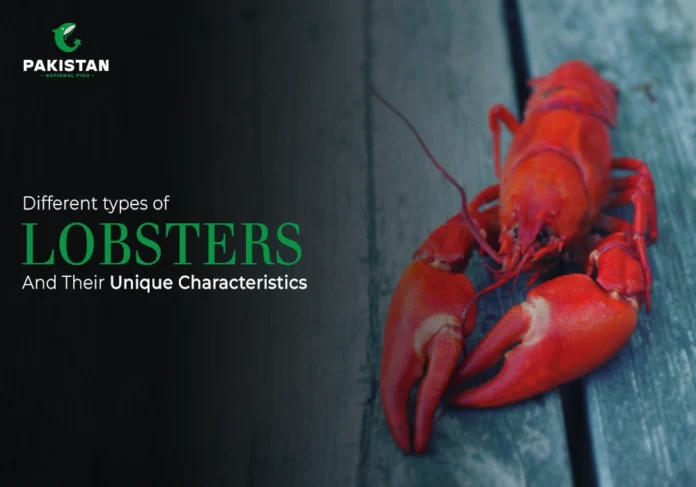Lobsters inhabit marine habitats while possessing hard shells combined with long antenna structures, and they develop forceful claws specifically in particular species. The oceanic species fall under two family categories, Nephropidae and Palinuridae, and occur throughout all sea regions. The types of lobsters are found in a wide range of marine habitats, including both Atlantic cold regions and Caribbean coral habitats.
Multiple species of lobsters display overwhelming differences in dimensions, weight, color, and physical attributes.
What Color Are Lobsters?
How Much Does a Lobster Weigh?
How Many Lobsters Are There in The World?
The Pacific Ocean Contains Lobster Species
Types Of Lobsters and Their Unique Characteristics
1. Clawed Lobsters
Clawed lobsters display two large claws positioned in front where one acts for crushing while the other performs cutting functions. These particular species inhabit exclusively northern Atlantic waters which remain cold throughout the year.
American Lobster (Homarus americanus)
- Habitat: North Atlantic Ocean (Eastern North America)
- Size: The American lobster reaches lengths of 4 feet while its body weight exceeds 40 pounds.
- Color: The natural color of the lobster appears as dark greenish-brown while the cooking process transforms it into a red hue.
- Unique Feature: The distinctive characteristic of this lobster species is its single-crushing appendage combined with its single-cutting appendage.
European Lobster (Homarus gammarus)
- Habitat: Eastern Atlantic and Mediterranean Sea
- Size: Divers can find American Lobsters measuring up to 3 feet during their habitat search in the North Atlantic.
- Color: The lobster has a dark blue shell that features speckled patterns.
- Unique Feature: European lobsters possess stronger claws than their counterparts from the American lobster species.
2. Spiny Lobsters (Rock Lobsters)
The defense mechanism of spiny lobsters consists of their exoskeletal spines combined with their lengthy antennae instead of using the large claws found in other lobster species. These types of lobster exist in ocean environments characterized by heat.
Caribbean Spiny Lobster (Panulirus argus)
- Habitat: Caribbean Sea and Western Atlantic Ocean
- Size: The species reaches full size when it reaches 2 feet in length.
- Color: Brownish with yellow spots
- Unique Feature: This species has elongated spiny antennae instead of large claw features.
California Spiny Lobster (Panulirus interruptus)
- Habitat: Pacific Ocean along the California coast and Baja California
- Size: These creatures expand to 24 inches during their lifespan.
- Color: Reddish-brown
- Unique Feature Feature: Important species in commercial fisheries
Japanese Spiny Lobster (Panulirus japonicus)
- Habitat: Pacific waters around Japan
- Size: These lobsters can achieve a size of 16 inches.
- Color: Their body has a dark red coloration which includes white spots.
- Unique Feature Feature: Considered a delicacy in Japanese cuisine
Pearl Lobster (Panulirus ornatus)
- Habitat: Indo-Pacific region
- Size: The lobster can achieve lengths exceeding 20 inches as an adult.
- Color: Its appearance features bright blue patterns on dark yellow pigmentation.
- Unique Feature: One of the lobster species stands out visually due to its distinctive characteristics
3. Small Lobsters
Although small in size these lobster species function effectively in marine biodiversity and commercial seafood industries.
Three Seas Fish and Lobster (Jasus edwardsii)
- Habitat: Waters around Australia, New Zealand, and South Africa
- Size: Typically 8–12 inches
- Unique Feature: This species has gained popularity because of its succulent tender meat that commands high value in the seafood market.
Sea Lobster (Panulirus homarus)
- Habitat: Indian and Pacific Oceans
- Size: Small to medium-sized
- Unique Feature Feature: Prefers rocky and coral reef habitats
Lobster Without Claws (Scyllaridae, or Slipper Lobsters)
- Habitat: Warm waters worldwide
- Size: These lobsters remain sized below the length of clawed lobsters.
- Unique Feature feature: Their Unique Feature characteristic includes an elongated flattened shape that enables them to conceal against sea floors.
Difference Between Hard Shell and Soft-Shell Lobsters
- Hard Shell Lobsters possess rigid shells because their developmental process has produced fully matured shells. These crustaceans hold more meat content so the fishing industry selects them for overseas shipments.
- Soft Shell Lobsters are recently molted crustaceans with delicate soft shells. The flesh of these crustaceans remains tender yet the amount of edible portion from their bodies decreases.
Difference Between Crayfish and Lobsters
The names crawfish and crayfish refer to the same species that seafood lovers commonly mistake for lobsters although crayfish and lobsters differ significantly.
- Habitat: Crayfish substitute freshwater lakes and rivers for their dwellings whereas lobsters occupy saltwater ocean habitats.
- Size: Lobsters usually surpass crayfish in size scale.
- Claws: Several such crayfish display small claws but these claws remain inferior to those of clawed lobsters.
Famous Lobsters
Various lobsters have attracted fame through their sensational larger size remarkable color patterns or distinctive characteristics.
- Big Bertha stands out as a massive lobster reaching a weight of more than 30 pounds.
- Blue lobster: Two distinguished examples of genetic mutations occur when blue colors replace regular brown pigmentation in blue lobsters.
- Albino lobster: The albino lobster remains an exceptionally unusual species because it exists once within every 100 million lobster specimens.


